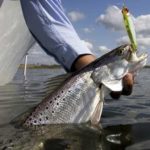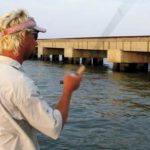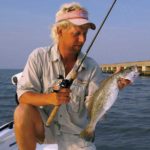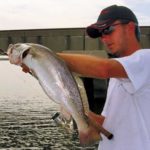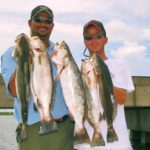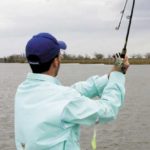
This lake will drive the average angler nuts. Follow these tips to make yourself more than just an average angler.
It’s often hard for anglers to believe the fishing reports they hear coming from Lake Pontchartrain. The problem is that their eyes rarely see what their ears hear. Lake Pontchartrain is a tough place to fish, and it often confounds the residents of Southeast Louisiana.
This contradiction between reports and reality hit me very strongly last year. I was out on the lake with Capt. Greg Schlumbrecht with To Fish Charters on a warm April afternoon. He had just provided information for a fishing report, and he wanted to prove to me that his report had merit.
My first clue that something wasn’t quite right came as we began chunking blue moon Deadly Dudleys toward the pilings. We had basically the same equipment, the same lures and were fishing the same place. For some reason, though, the trout didn’t like my Dudley nearly as much as they did Schlumbrecht’s.
I called my nephew that evening after I finished cleaning all those trout to see if he wanted to go back the next day to load up on fish again. We hit the water early the next morning, and headed right for the Trestle.
About three hours and three fish later, Schlumbrecht moved his boat in front of mine as I was leaving a piling I had just unsuccessfully fished. Not recognizing me in my bass boat, he made a cast to the piling I had just left, and caught a trout.
“You’ve got to be kidding me,” I hollered out to him. “I can’t believe you just did that right in front of me. I thought you taught me everything you knew about Lake Pontchartrain yesterday.”
“Not everything,” he shot back, suddenly realizing it was me. “We didn’t even scratch the surface.”
Scratching the surface is what most of us do when we try to catch trout at Lake Pontchartrain. We hit the Trestles, catch a couple trout and spend the rest of the night complaining about how there aren’t any fish in the lake.
However, there are quite a few anglers who have dug a little deeper. They are the ones who show up at CCA banquets with ice chests full of giant trout they caught that day. They are the ones who make a living guiding other anglers on this tough lake. And they are the ones who have built successful fishing tackle companies based on baits that work well on the lake.
Dudley Vandenborre, Greg Schlumbrecht, Eric Dumas, Terry Googins and Chas Champagne are all known for catching lots of Lake Pontchartrain trout and the largest Lake Pontchartrain trout. Whether they’ve been at it 30 years or three, these guys know how to fish the lake, and they all do things that most of us don’t.
Dudley Vandenborre
Widely known as a big-trout guy, Vandenborre, the creator of the Deadly Dudley line of soft plastics, says the No. 1 thing anglers can do to be more successful on the water, especially with big fish, is to slow down.
“I like to fish slowly and concentrate on areas where I know bigger fish live,” he said. “That’s usually the south shore and the Highway 11 Bridge. Big fish aren’t where you find a bunch of 2- and 3-pound trout — I call them the Mob. They’re off to themselves.”
Vandenborre describes fishing slowly as working all the angles of a piling and crawling a soft plastic slowly on the bottom. Too many times, anglers rush in and move on after making just a few casts.
“Working an area slowly and carefully is the way to catch those 7- to 9-pound trout,” he said. “When you fish a piling, make sure to cast all the way around it because you never know how a fish will be positioned on it. I try to hit four or five different angles on every piling I fish.”
The second part of fishing slowly, crawling a bait on the bottom, is just as important as working all the angles. Vandenborre says the key to getting a bait like a Terror Tail or Bay Chovey on the bottom is to use a heavy enough jig to get it down in the current, and to cast past the pilings so the current can roll the bait to the bottom of the pilings.
“Fishing this way won’t land you as many fish,” said Vandenborre, “but it will land you some bigger fish. And the best place to land these big fish by fishing slowly is the Highway 11 Bridge. We had a five-week run a few years ago when I had nine fish in my boat over 9 pounds, and they all came from Highway 11. I’ve never caught a 9-pound trout off the Trestle.”
Greg Schlumbrecht
The hardest thing to learn about fishing Lake Pontchartrain is just how lightly these trout bite. According to Schlumbrecht, the reason for the light bites is because these trout aren’t biting and running away from other fish when they eat. They bite and either sit right there or slowly move toward you.
“If you don’t have sensitive rods and sensitive line, you’ll never really know how many bites you’re actually getting,” said Schlumbrecht. “I fish the Fenwick Techna AV rods because they are really sensitive, and they have more eyes than less-expensive rods.”
The number of eyes might not mean much to average anglers, but Schlumbrecht explained that more eyes mean more contact points on a rod where the vibration transmitted through fishing line can be transferred to the rod.
“I always tell people that if they are going to spend $300 on a rod and reel, spend $200 on the rod and $100 on the reel. It’s really just a matter of buying the best equipment you can afford because you really do get what you pay for.”
Schlumbrecht also recommend trying some of the new fluorocarbon lines like the Berkley Vanish Transition. These lines have only 5-percent stretch, whereas regular monofilament line has up to 15-percent stretch.
“The whole thing about feeling a bite is the vibration up the line,” Schlumbrecht said. “The less stretch you have in a line, the faster it’s going to transmit the vibration of a bite up your line and to your rod.”
Schlumbrecht believes anglers are feeling one of two things when they get a bite at Lake Pontchartrain: They are either feeling the bait hitting the roof of the fish’s mouth, or they are feeling the fish’s mouth clamp down around the line.
“Bites are easier to feel in other places because the trout is actually eating the bait and swimming away,” Schlumbrecht said. “It’s not like that out here. Use sensitive rods and line to feel the bite, and you’ll catch more fish.”
Eric Dumas
Dumas has created quite a stir in fishing circles around the North Shore due to his incredible catches that he brings home and quickly posts on the fishing forums at www.louisianasportsman.com. He frequently takes calls from readers who want to do it like he does it, but until they put in the time to learn the lake, it’s probably not going to happen.
“You’ve got to fish the lake a lot before you really figure out what’s going on for yourself,” Dumas said. “You can go with a guide or somebody else, but learning what works best for you will keep you from getting skunked when you go by yourself.”
Dumas has spent upwards of three days a week on the water for the past eight years to learn Lake Pontchartrain. He learns something to do and something not to do just about every time he fishes the lake.
“The No. 1 thing putting in time on the lake has taught me is to not get discouraged when I don’t catch fish,” he said. “Just a month or so ago, I trolled the Causeway two days in a row. I caught 17 big fish the first day and only caught three the next. The difference is I had a good tide the first day and no tide the next. That’s the kind of stuff you have to learn for yourself.”
Those who think they don’t have the time to fish the lake three days a week need only to look to the evenings. As soon as there is enough light to fish the lake a couple hours after work, those who are really serious about learning the lake need to put in that time. Every little bit helps, and the evenings are actually among the best times to catch quality fish on Pontchartrain.
“Try something different every time you’re out,” Dumas recommended. “Change baits, try live bait, try different rigs. The key is to learn something when you catch fish and even more when you don’t.”
Terry Googins
It’s hard to find a fishing story about Lake Pontchartrain that doesn’t have a quote or two from Googins. He fishes the lake year round, and he says one of the best things anglers can do is to get away from the crowds, especially if they want an awesome topwater or jerkbait bite.
“From March through May, when the fish are heavy with eggs, they get on the shoreline from Slidell to Mandeville,” he said. “Places like Green Point, Cane Bayou, Bayou Liberty and Bayou Lacombe have some great grass beds around them. Find where the mullet are in that grass, and you’re set for some excellent fishing.”
Googins begins fishing the shallow grass beds early in the morning with walking topwater baits like a chrome/black or chartreuse Zara Puppy or a Top Dog Jr.
After the sun comes up, trout frequently move out toward deeper water, where Googins targets them with subsurface baits like a white/red Catch 2000.
“Although I’ve caught them as shallow as 1 and 2 feet,” Googins said, “I try to stay in 3 to 4 feet. Sometimes that depth is 200 yards off the shoreline, so don’t be afraid to move out as long as you have the right depth, good grass and bait.”
According to Googins, tide has very little affect on these trout. It does rise and fall, but the ability to get off the bank makes it easy to adjust. One of the keys to staying on this bite is to be willing to move if one area isn’t paying off.
“I catch a lot of 3- to 3 1/2-pound fish in this area,” Googins said. “But I’ve also caught them up to 7 pounds. The great thing about it other than the good fishing is that the area is rarely fished by other anglers — they’re too busy fishing the bridges.”
Chas Champagne
Like Dumas, Champagne has quite a following on the louisianasportsman.com fishing report board. The two fish together a lot, but Champagne is just as at home on his own as he is with Dumas.
“The first thing I tell people who get in the boat with me is to be a line watcher,” Champagne said. “This is something I harp on whenever I talk about Pontchartrain. Everybody is in love with braided line like Power Pro, but that stuff is almost impossible to see above the water. You’ve got to fish a line you can see.”
Champagne believes that even the best anglers on Lake Pontchartrain miss fish sometimes because they don’t feel the bite. However, they rarely have their eyes off of their line where it enters the water, so they don’t miss too many.
“When a trout picks up your lure the line will jump to the right or left,” Champagne said. “Sometimes you’ll just see it go slack above the water. The best way to see your line jumping is to do what Terry Googins taught me to do — fish with 17-pound-test original Stren fluorescent line. This line glows above the surface, and it makes it a lot easier to see when your line jumps.”
Champagne feels there isn’t anything wrong with fishing braided line on Pontchartrain other than it being hard to see. In other words, fish don’t shy away from biting because they see the line. Braided line is more sensitive than monofilament, but it’s lack of stretch makes it tough to feel a slack bite because it doesn’t transmit the vibration as well when it isn’t taut.
Lake Pontchartrain doesn’t have to be a tough place to fish. Try some of these expert recommendations, and see if your fishing success doesn’t improve.
If it doesn’t, you can come get in the boat with me to see if two heads are better than one.
